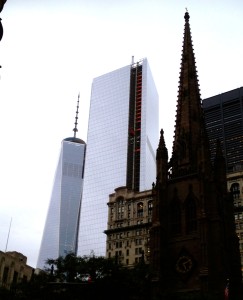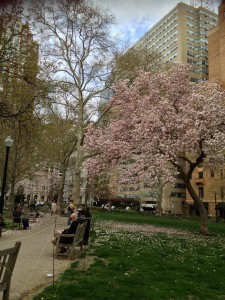
One World Trade Center (left with spire) was just named the tallest building in North America. Can mega-skyscrapers really be green?
It is well established that the construction and operations of buildings contribute almost 50% of all the greenhouse gas emissions in the United States — and making buildings more energy and resource efficient is one of the most immediate and measurable ways to address this growing concern. Since new and renovated high performing buildings, a growing number of which are LEED or green building rating certified, comprise less than 10% of the country’s portfolio, it is clear that the biggest and indeed the most important way to improve our impact on the planet is to improve the operations of our existing buildings The green building world is in the midst of some major transitions. And that’s saying a lot considering the past 10 years have seen nothing but transitions and transformations. The International Codes Council (ICC) has created a new green code, the International Green Construction Code (IGCC). LEED v4, the most comprehensive retooling that that groundbreaking rating system has seen in its fifteen years, is being launched at Greenbuild next week. But we won’t save the world by building our new LEED Platinum and net zero buildings. The only way we will save the world from climate disaster is by managing our buildings better, whether they are old or new. With many of our new high performance approaches to improving the design and operations of our buildings and sites, we have started by referring back to our earliest passive approaches and features. The best traditional ways to modify our landscape and moderate our environment included responding to nature and acknowledging the regional climate. James Steele in “Ecological Architecture: A Critical History” reminds us that, “To set tradition and technology against each other is to establish a false dialectic. Instead, when do they overlap and how is this applied to environmental problems?”

The Empire State Building, Chrysler Building and Secretariat at the UN Headquarters have all recently undergone retrofits to improve their energy efficiency.
There is a lot of talk about density and walkability in these new “green” times, and not all good. Edward Glaeser’s article in The Atlantic where he proclaims “all dense all the time,” arguing that urban development should be less restrained by policy; specifically, that redevelopment of low-density urban areas is necessary to supplying housing at pace with demand enough to keep housing prices affordable in the cities where people most want to live. Key features of cities such as historic districts and modern heritage are under threat by misplaced plans in the name of sustainability such as the Midcentury Un(Modern) report recently prepared by Terrapin Bright Green which suggests that an entire era of building stock is disposable based on the evaluation of one office building in midtown Manhattan. Applying “inefficient” to an entire era of buildings can be dangerous. Hence the controversy over Michael Bloomberg’s Midtown East rezoning plan, which would have allowed New York to replace aging commercial buildings with office towers taller than the Chrysler Building in East Midtown. The plan has received derision for promoting density over neighborhood, new over old, and bigger buildings without transit or street improvements.* What it also does is encourage demolition of existing buildings. But does one green approach, density, supersede another green approach — keeping what’s already here? *(The plan was effectively frozen this week when smarter, cooler heads prevailed – read about it here.)

Philadelphia’s Rittenhouse Square is the type of public space with low density that makes our cities so wonderful. We need balance in our cities not just density.
I can appreciate the importance density plays in cities like New York City, Chicago and San Francisco. But I don’t think making every place a city like Dubai or even midtown Manhattan is what’s good for our culture. It may from an intellectual viewpoint be good for the planet (maybe) but layering our density, our styles and the age of our buildings is what makes our lives and this planet interesting. It is up to us to figure out the balance. And as Kurt Vonnegut said, “Another flaw in the human character is that everyone wants to build and nobody wants to do maintenance.” That balance will be under discussion next week in Philadelphia when 30,000 green building professionals convene at Greenbuild and LEED v4 is officially launched. After three years of public review, it will finally be ready for prime-time. It will be the most comprehensive rethinking of the world’s largest green rating system with a bigger focus on operations and maintenance. Just when you thought you had LEED 2009 figured out!
Stay tuned, get ready for a wild ride! I’ll be posting from Greenbuild next week.
And if you’d like to “subscribe” or follow my blog, True Green Cities, please sign up through the “Subscribe” button at the bottom left of this page. You’ll receive a daily recap when new blogs are posted. Or Sign up for the Feed.
